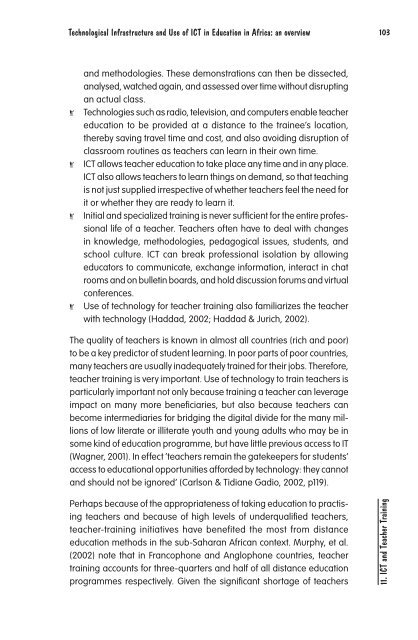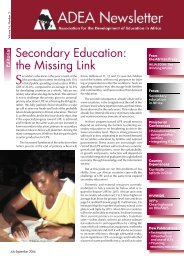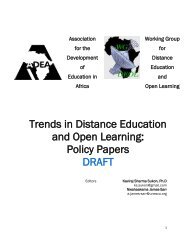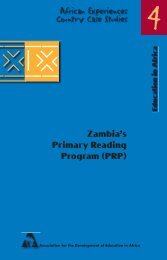Technological Infrastructure and Use of ICT in Education in ... - ADEA
Technological Infrastructure and Use of ICT in Education in ... - ADEA
Technological Infrastructure and Use of ICT in Education in ... - ADEA
You also want an ePaper? Increase the reach of your titles
YUMPU automatically turns print PDFs into web optimized ePapers that Google loves.
<strong>Technological</strong> <strong>Infrastructure</strong> <strong>and</strong> <strong>Use</strong> <strong>of</strong> <strong>ICT</strong> <strong>in</strong> <strong>Education</strong> <strong>in</strong> Africa: an overview<br />
103<br />
<strong>and</strong> methodologies. These demonstrations can then be dissected,<br />
analysed, watched aga<strong>in</strong>, <strong>and</strong> assessed over time without disrupt<strong>in</strong>g<br />
an actual class.<br />
Ù Technologies such as radio, television, <strong>and</strong> computers enable teacher<br />
education to be provided at a distance to the tra<strong>in</strong>ee’s location,<br />
thereby sav<strong>in</strong>g travel time <strong>and</strong> cost, <strong>and</strong> also avoid<strong>in</strong>g disruption <strong>of</strong><br />
classroom rout<strong>in</strong>es as teachers can learn <strong>in</strong> their own time.<br />
Ù <strong>ICT</strong> allows teacher education to take place any time <strong>and</strong> <strong>in</strong> any place.<br />
<strong>ICT</strong> also allows teachers to learn th<strong>in</strong>gs on dem<strong>and</strong>, so that teach<strong>in</strong>g<br />
is not just supplied irrespective <strong>of</strong> whether teachers feel the need for<br />
it or whether they are ready to learn it.<br />
Ù Initial <strong>and</strong> specialized tra<strong>in</strong><strong>in</strong>g is never sufficient for the entire pr<strong>of</strong>essional<br />
life <strong>of</strong> a teacher. Teachers <strong>of</strong>ten have to deal with changes<br />
<strong>in</strong> knowledge, methodologies, pedagogical issues, students, <strong>and</strong><br />
school culture. <strong>ICT</strong> can break pr<strong>of</strong>essional isolation by allow<strong>in</strong>g<br />
educators to communicate, exchange <strong>in</strong>formation, <strong>in</strong>teract <strong>in</strong> chat<br />
rooms <strong>and</strong> on bullet<strong>in</strong> boards, <strong>and</strong> hold discussion forums <strong>and</strong> virtual<br />
conferences.<br />
Ù <strong>Use</strong> <strong>of</strong> technology for teacher tra<strong>in</strong><strong>in</strong>g also familiarizes the teacher<br />
with technology (Haddad, 2002; Haddad & Jurich, 2002).<br />
The quality <strong>of</strong> teachers is known <strong>in</strong> almost all countries (rich <strong>and</strong> poor)<br />
to be a key predictor <strong>of</strong> student learn<strong>in</strong>g. In poor parts <strong>of</strong> poor countries,<br />
many teachers are usually <strong>in</strong>adequately tra<strong>in</strong>ed for their jobs. Therefore,<br />
teacher tra<strong>in</strong><strong>in</strong>g is very important. <strong>Use</strong> <strong>of</strong> technology to tra<strong>in</strong> teachers is<br />
particularly important not only because tra<strong>in</strong><strong>in</strong>g a teacher can leverage<br />
impact on many more beneficiaries, but also because teachers can<br />
become <strong>in</strong>termediaries for bridg<strong>in</strong>g the digital divide for the many millions<br />
<strong>of</strong> low literate or illiterate youth <strong>and</strong> young adults who may be <strong>in</strong><br />
some k<strong>in</strong>d <strong>of</strong> education programme, but have little previous access to IT<br />
(Wagner, 2001). In effect ‘teachers rema<strong>in</strong> the gatekeepers for students’<br />
access to educational opportunities afforded by technology: they cannot<br />
<strong>and</strong> should not be ignored’ (Carlson & Tidiane Gadio, 2002, p119).<br />
Perhaps because <strong>of</strong> the appropriateness <strong>of</strong> tak<strong>in</strong>g education to practis<strong>in</strong>g<br />
teachers <strong>and</strong> because <strong>of</strong> high levels <strong>of</strong> underqualified teachers,<br />
teacher-tra<strong>in</strong><strong>in</strong>g <strong>in</strong>itiatives have benefited the most from distance<br />
education methods <strong>in</strong> the sub-Saharan African context. Murphy, et al.<br />
(2002) note that <strong>in</strong> Francophone <strong>and</strong> Anglophone countries, teacher<br />
tra<strong>in</strong><strong>in</strong>g accounts for three-quarters <strong>and</strong> half <strong>of</strong> all distance education<br />
programmes respectively. Given the significant shortage <strong>of</strong> teachers<br />
11. <strong>ICT</strong> <strong>and</strong> Teacher Tra<strong>in</strong><strong>in</strong>g

















